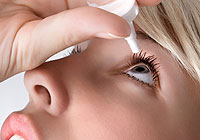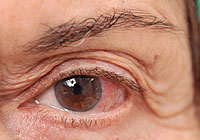Cataracts

A cataract is a cloudy area in the lens in the front of the eye. There is no pain associated with the condition but there are other symptoms, including:
- Blurred/hazy vision
- Spots in front of the eye(s)
- Sensitivity to glare
- A feeling of “film” over the eye(s)
People at risk for developing cataracts include those who are over 55, have had eye injuries or disease, have a family history of cataracts, smoke cigarettes or use certain medications.
For people who are significantly affected by cataracts, lens replacement surgery may be recommended, which is where the lens is removed and replaced with an artificial one called an intraocular lens (IOL).
Macular Degeneration

The macula is a part of the retina in the back of the eye that ensures that our central vision is clear and sharp. Age-related macular degeneration (AMD) occurs when the arteries that nourish the retina harden. Deprived of nutrients, the retinal tissues begin to weaken and die, causing vision loss. Patients may experience anything from a blurry, gray or distorted area to a blind spot in the center of vision.
AMD is the number-one cause of vision loss in the U.S. Macular degeneration doesn't cause total blindness because it doesn't affect the peripheral vision.
Possible risk factors include genetics, age, diet, smoking and sunlight exposure. Regular eye exams are highly recommended to detect macular degeneration early and prevent permanent vision loss.
Recent developments in ophthalmology allow doctors to treat many patients with early-stage AMD with the help of lasers and medication.
Dry Eyes

Dry eye occurs when the eyes aren't sufficiently moisturized, leading to itching, redness and pain from dry spots on the surface of the eye. The eyes may become dry and irritated because the tear ducts don't produce enough tears, or because the tears themselves have a chemical imbalance.
People usually begin experiencing dry eye symptoms as they age, but the condition can also result from certain medications, conditions or injuries.
Dry eye is not only painful, it can also damage the eye's tissues and impair vision. Fortunately, many treatment options are available.
Non-surgical treatments for dry eye include blinking exercises, increasing humidity at home or work, and use of artificial tears or moisturizing ointment. If these methods fail, small punctal plugs may be inserted in the corners of the eyes to limit tear drainage, or the drainage tubes in the eyes may be surgically closed. Eyelid surgery is also a solution if an eyelid condition is causing your dry eyes.
Blepharitis

Blepharitis is a chronic inflammation of the eyelids and eyelash follicles that can be caused by:
- Seborrheic dermatitis
- Bacterial infection
- Dry eyes
- Poor eyelid hygiene
- Rosacea
- Allergies
- Lice of the eyelash (rare occurrence)
These causes are associated with increased oil production of the glands near the eyelid, which traps bacteria and dirt, causing scaling of the irritated skin and excessive tearing. In addition, the eyelids may become crusty, swollen, itchy and reddened. In more serious cases, the eyelashes may fall out and sores may form on the eyelid. Complications can arise from blepharitis such as the infection spreading to the cornea as well as hastened chalazion and sty formation.
Treatment of blepharitis is usually limited to maintaining better hygiene around the eyelids. This may include some topical antibiotics and cessation of make-up use, but in many cases gentle cleansing of the area is all that is needed. Warm compresses can also help to lessen the symptoms and soothe the eye's discomfort.
Flashing Lights and Floaters

Although most flashes and floaters occur in people with healthy or merely nearsighted eyes, they can be symptoms of serious problems including injury and retinal and posterior vitreous detachments. Flashes in vision are caused by pressure on the retina, the bundle of nerves in the back of the eye where images are detected and transmitted to the brain. Patients complain of flashing lights or lightning streaks.
Floaters are often seen when fibers move within the vitreous humor, the gelatinous substance made of water and protein fibers that fills the eye. Patients complain of small specks or dots that ccan be seen against clear backgrounds. Serious vision loss can occur if the retina or vitreous detach from the eye wall. Patients experiencing flashes and floaters should contact their doctor immediately so an examination can be performed.
Conjunctivitis (Pink Eye)

Conjunctivitis, more commonly known as pink eye, is an infection and inflammation of the conjunctiva, the membrane that lines the eyelid and eyeball. The inflammation affects the blood vessels and gives the eye a pink or red appearance.
Pink eye is caused by a bacterial or viral infection and can be contagious, so diagnosis and proper treatment are important. It can also be caused by an allergic reaction or a foreign object in the eye. Symptoms of pink eye include redness and itchiness in one or both eyes, along with a discharge that may turn into a crust overnight. Excess tearing can also occur.
Treatment for pink eye depends on the cause. Your doctor may prescribe antibiotic eye drops or recommend over-the-counter drugs.
Ocular Trauma

Ocular Trauma refer to any type of trauma that occurs in or near the eye, and may be a result of an accident, scratch, puncture or contamination. An eye injury can be a traumatic event for patients of all ages, and may cause swelling, redness, bleeding, pain and other troubling symptoms.
Depending on the type and severity of the injury, treatment may include ice, aspirin, anti-inflammatory medication or surgery. Treatment should be sought as soon as possible, as severe eye injuries can sometimes lead to permanent damage. The best treatment against eye injuries is to prevent them from occurring in the first place by protecting your eyes and taking safety precautions whenever necessary.
To learn more about the Eye Conditions we treat, please contact us at 703-494-1766 today to schedule an appointment.

